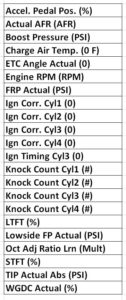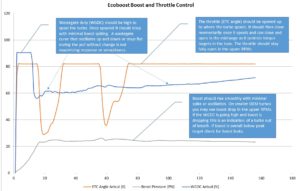We’ve had the opportunity to tune thousands of Ecoboost vehicles over the years and have developed a thorough understanding of the ECU and how it controls the engine. We also analyze A LOT of data from cars all over the world in all kinds of different configurations. Data analysis is a very important part of tuning the vehicle and making sure it is behaving and driving optimally.
As we refine and dial in the tunes, there are some key characteristics in the collected datalogs that indicate that the tune is well adjusted to the vehicle. In this article we go over tuning parameters you can check yourself by analyzing the logs from your own car.
The example vehicle used in this case is a Focus RS with an upgraded FMIC and catback and running 93 octane fuel. These key elements discussed in this article however apply to any Ecoboost powered car.
First things first – you have to valid data. Here are the parameters that we recommend datalogging for this exercise using your COBB Accessport (and here is how you set these up):
After you’ve setup your Accessport to datalog the correct parameters, it’s time to take some datalogs. There are two types of logs that we like to see because they highlight different aspects of how the engine is responding.
The first is a single, full gear pull. This can be done in 3rd or 4th gear. 4th gear will load the engine more and we prefer seeing this data ONLY if safe or possible. Press the logging button on the AP and wait for the numbers to start updating again on the screen. After this punch the throttle to the floor at 2500RPM and hold it there until the tach needle reaches the indicated redline.
The second type of pull is a multi gear pull. This is a demanding pull and it stress tests the tune and how it responds to fast changes. Good tunes behave predictably as you go through the gears. Here you start in 2nd and finish in 3rd (or 4th if safe). You once again punch the throttle and quick shift into the next gear near redline. No need to FFS, a fast shift is enough.
After the data is collected using a graphic software of your choice (Excel, Open Office, etc) to visually represent the data. Let’s start with the single gear pull.
FUEL
Correct fueling is essential for performance and reliability. These cars come with full time closed loop wideband control. That means that the ECU will try and achieve the fuel targets in the tune at all times using the OEM wideband sensor.
How much fuel to inject is primarily calculated based on the manifold pressure sensor (MAP) as there is no MAF sensor on these vehicles. Deviations from safe fuel targets means that either the tune is not dialed in, fuel system can’t supply the needed fuel, or the wideband sensor is not working properly. The charts below show you what to look for in a single gear pull datalog.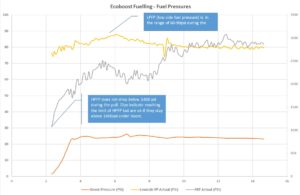
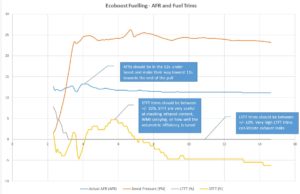
BOOST CONTROL
A turbocharged car with poor boost control is both unpleasant and unpredictable to drive as well as unsafe for the engine. The Ecoboost controls torque and boost control via the wastegate and throttle. The wastegate is used to spool the turbo and adjust the turbo speed and boost level in the charge air system. The throttle is used to finely adjust and trim boost without having to slow down the turbo. This makes for a very responsive system when dialed in correctly.
KNOCK CONTROL
The Ecoboost has a very responsive knock control system. It listens for knock at all times and reduces timing when it picks up knock-like noise. At WOT, it will add timing until it reaches the knock limit and also LEARN the octane quality via the OAR parameter. This is a very powerful system and if tuned well can exploit the full performance of the vehicle on the fuel it is using while keeping the engine safe from excessive knock. More about knock here.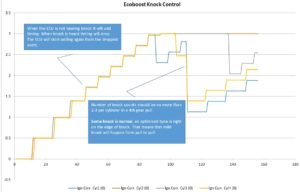
PUTTING IT ALL TOGETHER – THE MULTI GEAR PULL
Stress testing a tune is very important. This will tell you whether the tune is setup to take on daily driving tasks as well as track conditions. We don’t drive our cars in steady state WOT, we drive them in transient conditions (coming on and off the throttle at different RPMs all the time). Single gear pulls/sweeps don’t expose these areas and they are easy to miss especially if the tune is only done on a dyno.
If there are weaknesses in the tune you are likely to find them in a multi gear pull. Here’s what to look for in a multi gear pull above and beyond the single gear behavior found above.
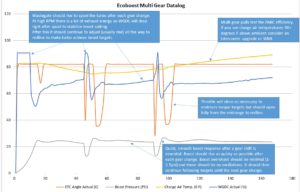
Feel free to contact us with any questions, and enjoy data analysis and making sure your tune is on point!


